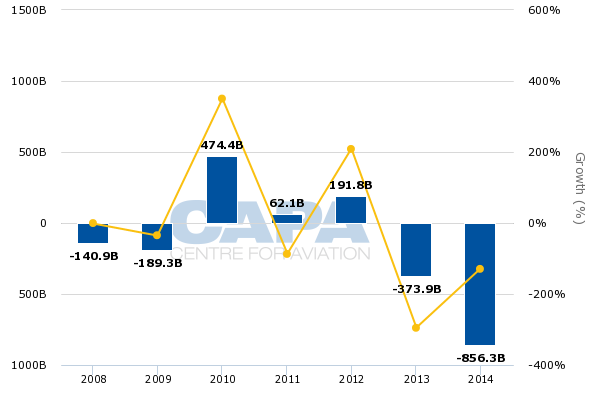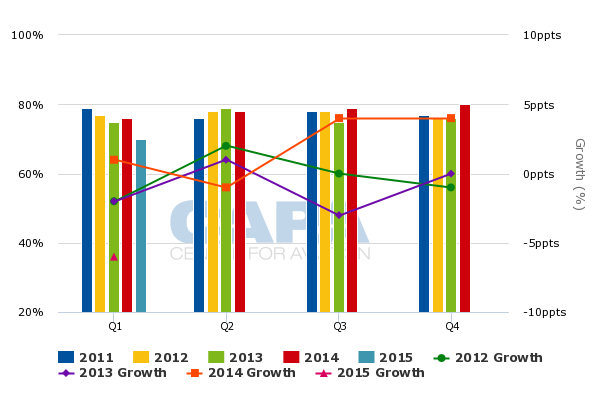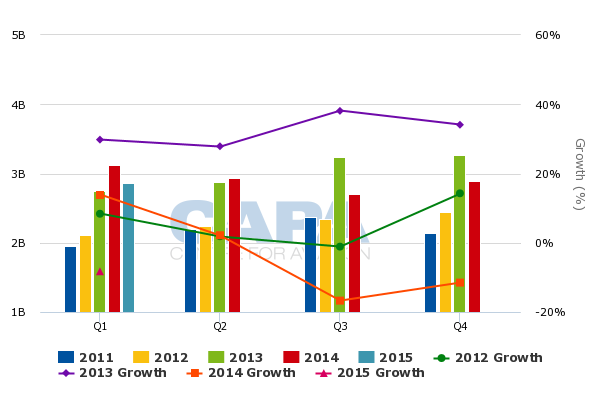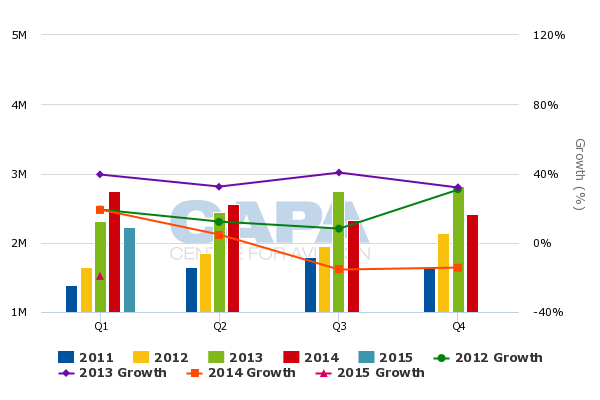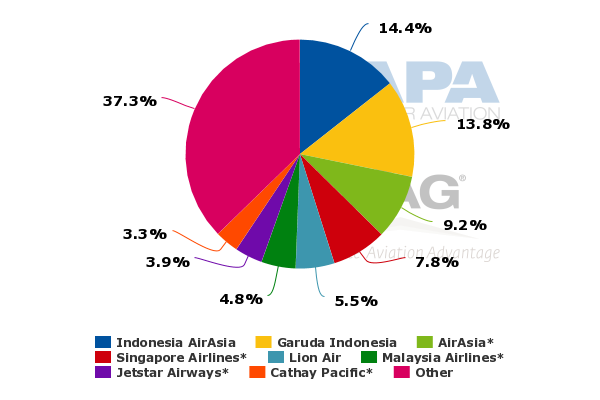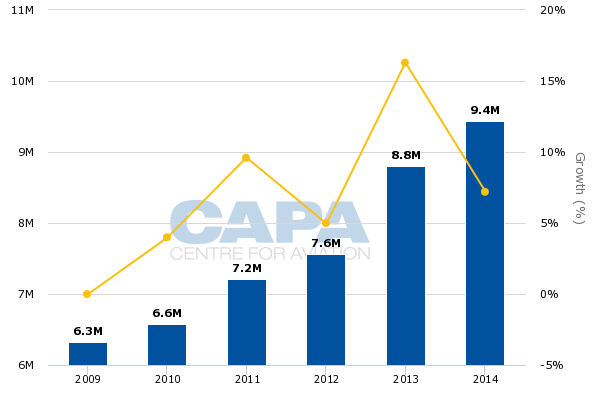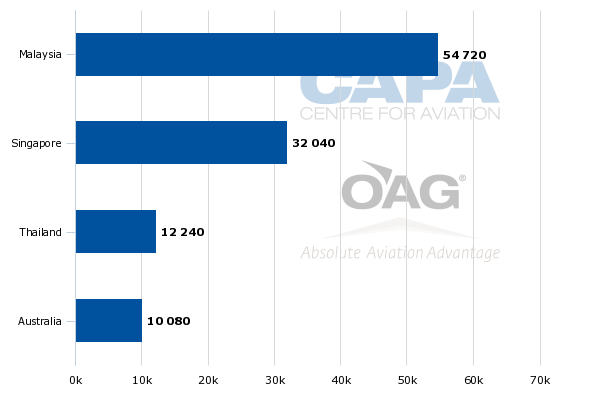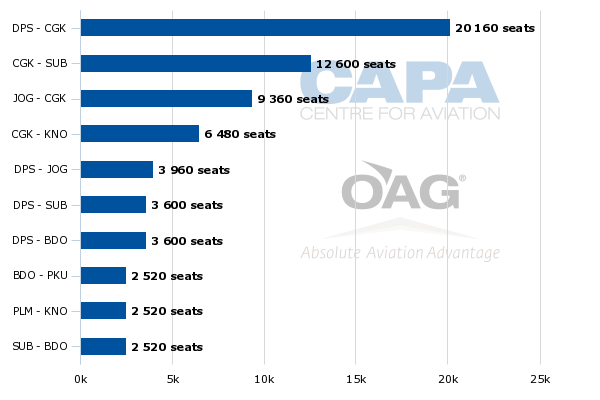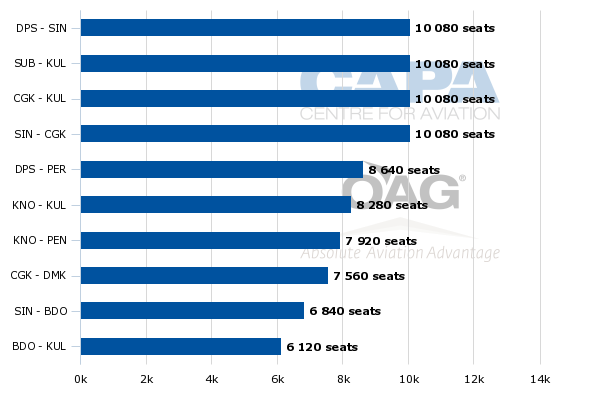AirAsia adjusts Indonesian operation but should be able to maintain leading international position
Indonesia AirAsia (IAA) is planning further capacity and network adjustments as part of turnaround efforts. IAA is shrinking its fleet but should be able to reduce unit costs as aircraft utilisation rates increase and cost reduction initiatives are implemented.
Despite its recent struggles IAA remains an important component of the AirAsia Group group's long-term strategy, particularly its international operation. The affiliate is also needed to feed new long-haul low-cost carrier Indonesia AirAsia X (IAAX).
IAA is expected to increase its focus on international operations, a sensible move given the challenges it has faced in Indonesia's highly competitive domestic market. AirAsia can afford to live without being a significant player in the Indonesian domestic market and should instead try to leverage its leading position in the country's relatively small but promising international market.
Indonesia AirAsia has been struggling financially
Indonesia AirAsia has struggled since 2H2013, when it was impacted by unfavourable market conditions and the rapid depreciation of the Indonesian rupiah. IAA incurred losses in three consecutive quarters from 4Q2013 through 2Q2014 but was back in the black in 2H2014.
While IAA was profitable through the first three quarters of 2013 and in 2H2014 it ended both years in the red at both an operating and net level. IAA was profitable in 2010 through 2012 after generally being loss-making during its initial five years of operations. IAA launched in 2004.
Indonesia AirAsia annual net losses (in IDR): 2008 to 2014
IAA was back in the red in 1Q2015 with an operating loss of IDR389 billion (USD29 million) and a net loss of IDR531 billion (USD40 million). The AirAsia Group is expected to report in late Aug-2015 another loss for IAA for 2Q2015.
An initial public offering, which was initially slated for 2012 but has been delayed multiple times, is now not expected to be pursued until at least 2017. IAA needs to first improve its financial position and prove to potential investors it has a viable long-term position.
Indonesia AirAsia embarks on another turnaround plan
The AirAsia Group has stated it expects IAA to be back in the black in 2H2015 and end the year roughly break-even, which would represent an improvement compared to 2013 and 2014. The Group announced in Jun-2015 a turnaround plan for IAA which includes removing four aircraft, cutting costs and increasing dependence on international traffic.
The turnaround plan, which will be implemented over the next few months, is the second restructuring attempt in just over a year. In mid-2014 IAA restructured its network and cut capacity.
In early 2014 IAA also dropped plans to add six aircraft in 2014, which would have resulted in a fleet of 36 A320s by the end of 2014. IAA did not add any aircraft in 2014 or 1H2015 but expanded very rapidly in 2012 and 2013, adding 13 aircraft. The expansion proved to be overly ambitious.
See related report: Indonesia AirAsia slows expansion. Domestic share to suffer but international position to strengthen
The network adjustments which were implemented in mid-2014 initially seemed to be effective as the airline again reported operating profits in both 3Q2014 and 4Q2014. In reporting 1Q2015 financials in late May-2015, the AirAsia Group remarked IAA was on a "good turnaround track" until the 28-Dec-2014 crash of one of its A320s. The AirAsia Group halted marketing activities following the QZ8501 incident, leading to a reduction in demand in 1Q2015.
IAA's passenger numbers were down an alarming 26% in 1Q2015, outstripping a 19% decline in seat capacity. As a result its seat load factor dropped by 6ppts to 70%, the lowest load factor for IAA in at least four years. (Note: AirAsia does not report monthly operating figures and 2Q2015 figures will not be available until Aug-2015.)
Indonesia AirAsia quarterly seat load factor: 1Q2011 to 1Q2015
The one-month suspension of marketing activities however should not be seen as the only contributor to IAA's poor performance in 1H2015. Indonesia typically sees seasonally weaker demand in the first half. While IAA was back in the black in 2H2014 it was too early to determine if the adjustments made in mid-2014 were sufficient for the airline to be profitable on a year-round basis.
Indonesia AirAsia should be able to improve utilisation rates as fleet is cut
Relatively low aircraft utilisation levels has particularly been an issue impacting profitability. IAA did not reduce the size of its fleet in 2014 while cutting capacity, resulting in excess aircraft.
IAA's ASKs were down 4% for the full year in 2014 while seat capacity was down 3%. But ASK and seat capacity levels only began tracking down in 3Q2014 as most of the network cuts from the previous turnaround attempt were implemented in Jun-2014 and Jul-2014.
Indonesia AirAsia quarterly ASKs: 1Q2011 to 1Q2015
Indonesia AirAsia quarterly seats: 1Q2011 to 1Q2015
In 3Q2014, seat capacity was down 15% while ASKs were down 17%. In 4Q2014 seat capacity declined by 14% and ASKs declined by 11%. But IAA had a larger average fleet size in 3Q2014 and 4Q2014 compared to 3Q2013 and 4Q2013. In 2013 IAA added eight aircraft for a total of 30 A320s, with most of the deliveries taking place in 2H2013.
In 1Q2015 IAA operated one less aircraft than 1Q2014 due to the crash of QZ8501. But ASKs were down 8% and seat capacity 19%, resulting in lower aircraft utilisation rates. ASKs were up only 4% compared to 1Q2013 levels although IAA operated seven more aircraft in 1Q2015 compared to 1Q2013.
IAA is now planning to reduce the size of its fleet in 2H2015 by four aircraft, which would give the affiliate 25 aircraft at the end of 2015. The AirAsia Group plans to move two aircraft to Thailand, one to Malaysia and one to India.
A 25-aircraft fleet should enable IAA to reduce its costs and improve utilisation rates. Further capacity cuts are also expected but could be relatively modest as IAA should be able to come close to maintaining current capacity levels with a 25-aircraft fleet.
Indonesia AirAsia expected to reduce domestic capacity
IAA has not filed any major schedule changes for 2H2015 but is now in the process of again reviewing its network. IAA currently operates about 1,000 weekly flights and for now its current schedule indicates maintaining a similar level of flights through the end of 2015, according to OAG data.
The current schedule for 2H2015 also shows IAA maintaining its current domestic/international mix of approximately 400 weekly domestic flights and 600 weekly international flights. But this could change as the AirAsia Group has stated that IAA will increase its reliance on international traffic.
Over the years IAA has struggled domestically and multiple attempts to become a more significant player have generally been unsuccessful. The last major domestic push came in 2013 as most of the capacity generated by the eight additional aircraft received in 2013 were allocated to the domestic market. IAA also pursued domestic expansion in 2012 as it added five A320s.
IAA currently has about 70,000 weekly domestic seats, which represents a doubling of capacity since 2011 and approximately 50% growth since 2012. Domestic capacity was reduced slightly in 2014 as the network was rationalised but the new network restructuring exercise could lead to more significant domestic cuts.
Despite the growth over the last four years AirAsia is still a relatively insignificant player in the Indonesian domestic market, with only about a 3% share. AirAsia seems to have come to the recognition that establishing a meaningful presence in the Indonesian domestic market is too difficult given the unique characteristic of the local market and the much larger size of its competitors. Essentially giving up on the largest domestic market in Southeast Asia (and the fifth largest in the world) will be painful but is the sensible move.
AirAsia has leading position in Indonesia's international market
International expansion offers a much more promising opportunity for IAA given AirAsia's much stronger position in the international market.
AirAsia currently accounts for about a 25% of total seat capacity in Indonesia's international market, including nearly a 15% share for IAA and about a 9% share for Malaysia AirAsia. IAAX also about a 1% share of the Indonesian international seat capacity while Thai AirAsia has about a 0.3% share.
Indonesia international capacity share (% of seats) by carrier: 6-Jul-2015 to 12-Jul-2015
The AirAsia Group should not give up on Indonesia entirely as there is still a viable and growing niche in the international market. While its Malaysia-based subsidiary is the largest foreign carrier in the Indonesian market, the group still strategically needs an Indonesian affiliate to maintain its position in the Indonesian international market.
AirAsia is particularly strong in the inbound sector, which should continue to see growth as Indonesia emerges as popular tourist destination. Indonesia has seen visitor numbers increase by 50% over the last five years including by 16% in 2013 and 7% in 2014.
Indonesia annual visitor numbers: 2009 to 2014
Singapore, Malaysia and Australia are Indonesia's largest source markets, accounting for 3.3 million of the 9.4 million visitors recorded in 2014. These are also three of IAA's four international markets, accounting for almost 90% of its international seat capacity.
Indonesia AirAsia international capacity (seats) by country: 6-Jul-2015 to 12-Jul-2015
While it has a relatively weak distribution presence within Indonesia, AirAsia has the advantage of a stronger brand overseas than most of its competitors, leaving it well placed to expand as Indonesia continues to see growth in visitor numbers.
AirAsia has opportunities to further expand in Bali
AirAsia will likely continue to focus on Bali, which is one of five bases for IAA and is the only base for IAAX. Bali is Indonesia's largest tourist destination and continues to see a rapid increase in passenger traffic, driven by strong inbound demand.
The group also needs IAA to feed IAAX in order for the new long-haul LCC to succeed. IAAX currently links Bali with Taipei and Melbourne and is looking at adding flights to Brisbane, Sydney and Tokyo in 2H2015 as it adds a third A330-300.
See related reports:
- Indonesia AirAsia X faces regulatory hurdles & delays but is finally cleared to launch Melbourne
- AirAsia X starts to show improvements following capacity cuts. Full recovery could hinge on MAS
IAA currently links Bali with six international destinations - Bangkok, Darwin, Kuala Lumpur, Kota Kinabalu, Perth and Singapore. It also operates five domestic routes from Bali, which are unlikely to be cut as they are needed to feed the international flights operated by IAA and IAAX.
Four of IAA's domestic routes from Bali are already among its top 10 domestic routes. IAA has only seven domestic routes which are currently served with more than seven weekly frequencies, including Bali-Jakarta, its largest route with eight daily frequencies, as well as three other Bali routes and three other Jakarta routes.
Indonesia AirAsia top 10 domestic routes based on seat capacity: 6-Jul-2015 to 12-Jul-2015
More domestic and international routes from Bali are likely given the group's focus on international passengers and the inbound market. Expansion at Bali is also strategic as slots at the airport, which has new terminals but only one runway, are starting to run out. AirAsia currently accounts for about a 17% share of total seat capacity at Bali, including about a 20% share of international capacity and about a 14% share of domestic seat capacity.
Jakarta also remains strategically important
Jakarta (CGK) is IAA's largest base, accounting for about 45% of the carrier's total seat capacity compared to 33% for Bali (DPS). IAA will be keen to maintain capacity at Jakarta as any cuts would result in ceding valuable slots to competitors.
Indonesia AirAsia top 10 bases/stations ranked by seat capacity: 6-Jul-2015 to 12-Jul-2015
AirAsia could potentially pursue expansion on international routes from Jakarta by reducing capacity on domestic trunk routes from the capital, where it faces stiff competition and with the exception of Bali are no longer strategically important. IAA currently operates five international and four domestic routes from Jakarta. IAAX also operates from Jakarta to Jeddah and is planning to take over some of IAA's flights between Jakarta and Bali.
IAA also has bases at Bandung (BDO), Medan (KNO) and Surabaya (SUB). Bandung or Medan could potentially be cut as they are small (less than five aircraft). Surabaya is Indonesia's second largest city and the third largest base for IAA after Jakarta and Bali.
Bandung is the only base that currently has less seat capacity than 2012. But Bandung-Kuala Lumpur and Bandung-Singapore have been two of IAA's most successful routes. Both are among the 10 largest international routes for IAA.
Two of three international routes from Medan, Kuala Lumpur and Penang, are also among the top 10.
Indonesia AirAsia top 10 international routes based on seat capacity: 6-Jul-2015 to 12-Jul-2015
Indonesia AirAsia could reduce presence in some secondary cities
IAA also serves Bangkok from Medan but it suspended services to Singapore from Medan in Jul-2014. At the same time it dropped Medan-Pekanbaru, leaving it with three domestic routes from Medan - Jakarta, Palembang and Yogyakarta.
None of the Medan domestic routes are strategically important. AirAsia could still potentially maintain a presence in Medan using Malaysia AirAsia, which also serves Medan from Kuala Lumpur and Penang. If the Medan base is cut IAA could also still operate some flights to Medan using aircraft from other bases.
The network rationalisation exercise from mid-2014 also included exiting Makassar entirely, a city in central Indonesia that had been served from Bali and Surabaya. A resumption of services to Makassar is now reportedly under consideration. But Makassar does not seem strategically important as it is mainly a domestic destination and is generally used by airlines as a hub to serve the more remote eastern region of Indonesia.
AirAsia at one point planned to establish a base at Makassar as part of a plan to expand its presence into eastern Indonesia. But given the new focus on international operations, in particular markets with inbound demand, it would be logical for IAA to continue to focus on Bali and Jakarta.
Indonesia AirAsia to launch Padang-Singapore and resume Surabaya-Bangkok
In mid-2014 IAA also reduced Jakarta-Singapore from six to four daily flights. Jakarta-Singapore had been IAA's largest international route; it now shares this distinction with Jakarta-Kuala Lumpur, Surabaya-Kuala Lumpur and Bali-Singapore, all of which are also currently served with four daily flights. Jakarta-Kuala Lumpur and Surabaya-Kuala Lumpur are larger routes for AirAsia overall when also considering the flights operated by its Malaysian subsidiary.
IAA also dropped Surabaya-Bangkok in Jun-2014 but is now planning to resume the route. The AirAsia booking engine shows IAA commencing four weekly flights from Surabaya to Bangkok from 4-Sep-2015. This could be the first of several new or resumed international routes for IAA as it looks to reduce its reliance on the domestic market.
For example, IAA recently secured traffic rights and slots for Padang-Singapore and is expected to launch the route within the next few months. Padang would be a new destination for IAA but is already served by Malaysia AirAsia from Kuala Lumpur.
IAA's network currently includes 10 destinations in Indonesia as well as nine international destinations including four in Malaysia, two in Thailand, two in Australia and Singapore. Solo became IAA's tenth Indonesia destination in early 2015, when it launched thrice weekly flights from both Bali and Singapore.
But IAA is planning to cut Singapore-Solo as part of the upcoming network adjustments. IAA has been considering other new domestic routes from Solo but domestic expansion at Solo would not be in line with IAA's overall new strategy.
AirAsia reaches critical juncture in Indonesia
AirAsia's Indonesian operation is at a critical juncture. IAA has been struggling financially while IAAX has faced multiple regulatory setbacks which has led to costly delays in launching new routes.
The situation was exacerbated on 11-Jul-2015 as IAA received a letter from Indonesian regulators stating it needs to have positive equity by the end of Jul-2015. The regulator has since clarified that the 13 Indonesian airlines which are not meeting the newly enforced equity requirement do not risk losing their license but will be subject to a review of new route applications and will need to submit a business plan ensuring positive equity.
Meeting the requirement should not be an issue for IAA and the airline should be able to avoid a reassessment of route applications. IAA was already working on restructuring its finances and has been in the process of raising USD100 million in fresh capital through new convertible bonds.
AirAsia will get through the current turbulence. Shutting down its two Indonesian affiliates is unthinkable. Indonesia is a strategically critical market for Asia's leading LCC group.
Domestic reductions are sensible as AirAsia has clearly lost the battle for Southeast Asia's largest domestic market to Lion Air and Garuda budget subsidiary Citilink. But AirAsia cannot afford to cede its leading position in Indonesia's much smaller international market, which has huge growth potential as the inbound visitor numbers continue to grow and Indonesia's middle class continue to expand.
AirAsia will never by the largest airline group in Indonesia. But with the right network it can still carve out a profitable niche with a fleet of 25 A320s and a handful of A330s.
